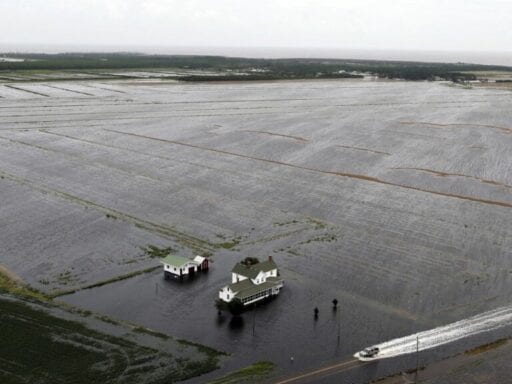The most telling images we’ve seen so far from Florence’s path.
The remnants of Hurricane Florence are finally exiting the Carolinas. The region has been deluged by historic amounts of rainfall — best measured in feet in many locations — and floodwaters along rivers inland are still rising. Wilmington, North Carolina, saw nearly 27 inches of rain. Other locations saw more than 30. Sand dunes disappeared from the coast in the storm surge.
The hazards associated with this storm haven’t ended; rivers are swollen and still rising, and there’s a risk that dams could be breached. And in the meantime, we’re getting a clearer sense of its toll.
At a news conference on Monday, North Carolina Gov. Roy Cooper confirmed there were 24 storm-related deaths in his state. Some 2,600 people and 300 animals have been rescued, he said, and rescues are still “ongoing.”
“Even though the rain is moving away, the ground is saturated,” Cooper said. “Even a small amount of rain can cause flash flooding.” In total, USA Today reports, the storm has claimed 32 lives, including an infant.
In North Carolina, 314,000 customers are without power. Additionally, there are at least 4,400 customers in South Carolina and 6,800 in Virginia without power. Many roadways are still dangerous and flooded.
And there are environmental hazards as well: 2,000 cubic yards of coal ash — a toxic byproduct of coal power production — spilled from a landfill near Wilmington on Saturday and a second breach was reported Monday. It’s yet unclear if the spill washed into the Cape Fear River, which could potentially transport the heavy-metal-laden ash to the ocean. The North Carolina Department of Environmental Quality told the Washington Post that lagoons filled with hog waste at several hog farms had been overtopped by floodwaters.
There will be a lot of cleaning up, damage assessment, and rebuilding to do. Here’s what the situation looks like on the ground.
/cdn.vox-cdn.com/uploads/chorus_asset/file/13108873/GettyImages_1034838512.jpg) Joe Raedle/Getty Images
Joe Raedle/Getty Images/cdn.vox-cdn.com/uploads/chorus_asset/file/13101265/GettyImages_1034802216.jpg) Mark Wilson/Getty Images
Mark Wilson/Getty ImagesDevastating destruction from #Florence pic.twitter.com/I0elw0g56O
— AMHQ (@AMHQ) September 17, 2018
/cdn.vox-cdn.com/uploads/chorus_asset/file/13101335/AP_18260536128596.jpg) Steve Helber/AP Photo
Steve Helber/AP Photo/cdn.vox-cdn.com/uploads/chorus_asset/file/13101321/AP_18260077815005.jpg) David Goldman/AP Photo
David Goldman/AP PhotoSurf City, North Carolina before and after Hurricane Florence. Amazing to see the piers/stilts doing their job. Crazy to see the sand dunes disappear into the road. pic.twitter.com/OgnuA3v3By
— Adam Epstein (@AdamWGME) September 17, 2018
/cdn.vox-cdn.com/uploads/chorus_asset/file/13101075/GettyImages_1034524074.jpg) Joe Raedle/Getty Images
Joe Raedle/Getty Images/cdn.vox-cdn.com/uploads/chorus_asset/file/13101089/GettyImages_1034481230.jpg) Mark Wilson/Getty Images
Mark Wilson/Getty Images/cdn.vox-cdn.com/uploads/chorus_asset/file/13101263/GettyImages_1034344444.jpg) Mark Wilson/Getty Images
Mark Wilson/Getty Images/cdn.vox-cdn.com/uploads/chorus_asset/file/13101225/GettyImages_1033806068.jpg) Joe Raedle/Getty Images
Joe Raedle/Getty Images/cdn.vox-cdn.com/uploads/chorus_asset/file/13101205/GettyImages_1032891040.jpg) Chip Somodevilla/Getty Images
Chip Somodevilla/Getty Images/cdn.vox-cdn.com/uploads/chorus_asset/file/13101217/GettyImages_1032890856.jpg) Chip Somodevilla/Getty Images
Chip Somodevilla/Getty ImagesRobert Simmons Jr. was among those seeking refuge Friday afternoon in New Bern, North Carolina during Hurricane #Florence along with his kitten – named “Survivor.” https://t.co/3wqVC8P1yZ pic.twitter.com/wJ6WHGP6J6
— ABC News (@ABC) September 16, 2018
Correction: An earlier version of this story stated the power outages in terms of the number of people affected. In fact, the correct metric is customers. The story has been updated.
Author: Brian Resnick



